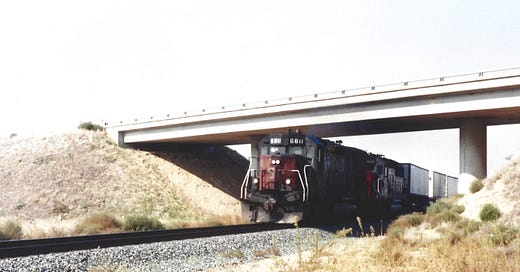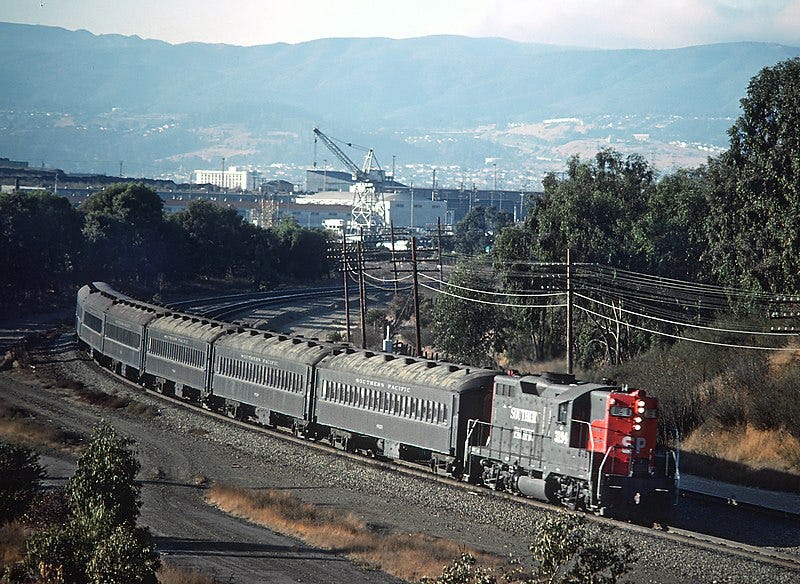What ‘The Friendly’ S-P Was To Me

So today, I thought I would take some time to share a few personal anecdotes of this, for me, close-to-home enterprise. And, by close to home, I mean that literally.
Okay, so let me begin by saying that I consider myself lucky to have seen the SP in action. It is without a doubt the first railroad that I paid really, really close attention to. That couldn’t be helped. In attending college in the early 1970s at Cal Poly, SLO, where the SP’s trains wended their way past on a sliver of line bisecting a portion of the campus grounds themselves, how could I help but not notice?! The truth is, I couldn’t.
In fact, it was on the Southern Pacific that I was introduced to a practice involving the insertion in long freight trains ascending and descending Cuesta Grade of helper or pusher engines — locomotives, typically placed two-thirds of the way back in the train consist from the head-end, thus providing an extra assist if you will; the train without such power added, would have been hard-pressed to make it over the grade if at all.
Just one other point. Adding helpers deep in the train consist, meant having to break the train apart, at which point the helper locomotives would be spliced in, the train then reassembled (though this time in slightly reconfigured arrangement), and with the proper amount of applied air pressure in the brakeline, the fully assembled train being ready to roll.

Once over the top of Cuesta Grade, in Santa Margarita, helpers would cut out (or cut off), the train then reassembled into its original configuration and once more with proper brakeline air-pressure check made, once again said train would be on its way, provided, like earlier at the bottom of the hill, dispatcher authority to do so was given. All of this consumes a given amount of time, that, of course, must be factored in.
Meanwhile, while living in the San Francisco Bay Area, I was afforded an up-front-and-personal look at the railroad’s peninsula commuter-train ops.
It was as if I was getting a classroom-based education without actually being in one; the classroom, that is.

Jumping ahead some 15 to 20 years later, after I had planted roots in Fresno and had become involved in the railroad-public safety initiative Operation Lifesaver as a volunteer, I got to meet several employees as well as, on occasion, ride in company locomotives that were then engaged in grade-crossing-safety-related campaign activities. One such activity is known as “Officer On The Train” — an exercise involving law enforcers placed inside the trains with other officers stationed on the ground in patrol cars stationed near targeted crossings where tickets were issued to unsuspecting motorist violators who had, for example, driven around lowered crossing gates ahead of the train’s approach. When I was onboard, I never saw any violations being committed. I would then proceed to do a write-up about those accounts for possible future publication in the program newsletter California Lifesaver.
The Southern Pacific Railroad was once dubbed “The Friendly,” and I could definitely see why that was.
Updated: Jan. 19, 2025 at 8:08 p.m. PST.
Image credits: 3rd - Roger Puta via Wikimedia Commons; all others - Alan Kandel
All material copyrighted 2025, Alan Kandel. All Rights Reserved.




